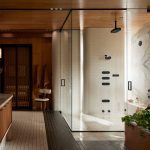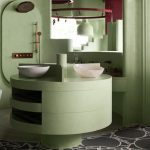Sweetwater House
Text description provided by the architects. Located in Frankston South on Bunurong Country and backing onto the regionally significant Narringalling (Sweetwater Creek), Sweetwater House provides flexibility and respite for a maturing family.

GALLERY
Designed and built during Melbourne’s extended COVID lockdowns, the home reflects an inventive response to low-cost, multi-generational and sustainable living, while also telling a story of personal and ecological renewal.
Our ambition was to create a materially honest and highly sustainable home for our family of four. We developed a plan arrangement that could adapt to the changing needs of two teenage children and allow for multi-generational living and visits from family interstate. Parent and children’s bedrooms are located at separate ends of the house, each with generous garden views, while a series of one, two and four metre spatial arrangements create ‘zones’ that encourage different modes of occupation.

The gravitational heart is an open-plan living room and kitchen overlooking the creek to the north over a generous deck and a small orchard of fruit trees. The space doubles as an area to entertain guests, with large doors opening to an expansive outdoor lawn and entertainment area that in turn brings the bush surrounds into the home. The home’s exposed mass timber interior has an enduring and tactile quality, illuminated throughout by low-voltage LED track lights and embedded linear lights. In the bedrooms, the combination of a lowered ceiling, plush wool carpet, and flowing linen curtains create a sense of compression and embrace. Inside, stainless steel accents and fine porcelain tiles and benchtops balance the visual weight of the timber en masse.
Door hardware and tapware all feature knurled levers, which promote a graduated tactile spatial experience. On surfaces throughout, four different shades of soft green laminate respond to subtle changes in daylight and reference the surrounding bushland. The house’s paired-back material scheme and clean lines respond to its local architectural context, with prominent examples of mid-century design in the area including the seminal ‘McClune House’ by Robin Boyd. Honoring the landscape was central to the design. The home’s large windows and clear sight lines to the creek create a feeling of living among the bush, elevating the family’s everyday lives and encouraging enjoyment of the outdoors from within.

The home’s unique dual entry points allow for flexible multi-generational habitation. The primary entrance provides direct access to the master bedroom and main living space, and the second entrance provides access to the kids’ bedrooms, lounge, and bathroom areas. A door can be introduced to provide separation within the plan and provide privacy for the maturing family, if required.
Drawing on knowledge and experience gleaned from previous mass-timber projects, the home was constructed using a prefabricated construction methodology that offered both a highly time- and cost-effective solution and vertical supply chain security. The home is constructed from 66.8m3 of CLT sourced from PEFC-certified, sustainable softwood plantations in Southern New South Wales. During its growth, the CLT sequesters 49.42 tonnes of C02 and, even accounting for the energy used in manufacturing, has a total negative embodied carbon emission of 32.86 tonnes.

The CLT manufactured by XLam Australia is certified as being Red List free, which means it is free from adhesive polyurethane formaldehyde and 100% recyclable at the end of life. The project involved close collaboration with a specialist mass timber engineer and the erection/construction team – a hands-on process that involved ongoing engagement throughout design and delivery. It was understood when the site was purchased that there would need to be a significant commitment to the regeneration of the site’s ecology, extending into Sweetwater Creek.
As a result of the more recent occupation of the land there is an existing orchard and olive tree grove, which have been retained and enhanced. However, this was accompanied by many non-Indigenous shrubs and weed species, including swathes of bamboo. Sweetwater Creek has a similar history of intervention when the main sewer was installed in 1973, with the ecology suffering considerable destruction. With the support of the Melbourne Water Stream Frontage Management Program, there are now four adjacent properties undertaking management works with aspirations to seek further support from property owners sharing the creek.

The site was also subject to the burying of construction waste, which was identified during the groundworks for the building and subsequently removed. Rainwater is harvested off the 268m2 roof and is retained in 2 x 500 litres underground tanks. This water is fed to all toilets and is available for irrigation use. The tanks are located so they can provide gravity fed water to the original Orchard and vegetable garden that is located to the north of the house.
The fully electric home employs a next generation AC PV system that to date provides more than the total daily energy demands. The site has a direct northerly aspect, informing the elongated form of the building to allow solar ingress into the habitable spaces. Eaves that extend over the windows of the shared living areas have been designed to provide deep ingress of the sun in winter and limit the sun’s penetration in the summer months.

The southern elevation features high-level clerestory windows that provide views of the tree canopies from inside and capture sea breezes from the southwest that help to cool the house in the evening. Passivhaus design principles are core to this project, with Sweetwater House speculating on the potential future of suburban residential design. Achieving an 8-star NatHERS rating and expected energy consumption of 56Mj/m2 per year, the project goes beyond the requirements of the analysis software in terms of solar ingress and shading, cross ventilation, thermal mass, and material selection.
Combined with its surrounding tree ferns and encircling eucalypts, the home’s warm timber palette creates a strong sense of welcome and calm. The creek, which is currently undergoing rehabilitation, forms part of a unique ribbon of bushland and walking tracks that are central to the local community. The creek environment is visible from the road, and it was important for the design of the house to remain visually permeable, retaining this vista for passersby.
Architects | Christopher Botterill, Jackson Clements Burrows Architects
Photographs | Tom Blachford
Danish architect Kristian Ahlmark has designed a kitchen unit for the Lithuanian brand KongaCph, crafted from a single ...
The Skywalk kitchen by Eggersmann makes a bold statement with its striking combination of White Tiger granite and ...
The Enviro-Green Waste Machine by Abey offers a sleek and innovative solution to managing kitchen scraps, making it ...
Kohler has unveiled its Anthem+ Digital Showering System that creates an immersive experience for its users. Adjustable via a custom ...
MuseLAB's new Mumbai showroom for bathware brand Aquant is an innovative way to experience a bathware discovery space. ...














